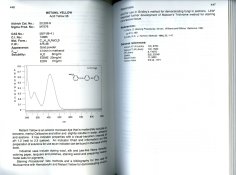From Cooke Site :
Technicolor
The year 1931 marked a further achievement. During the development of the Technicolor colour process, it became evident that the provision of a beam-splitting prism behind the objective in the Technicolor 3-strip camera made it impossible to use the wide angle objectives generally available at that time. The problem then, was to provide a lens of short focal length and wide relative aperture having the long back focal distance necessary to clear the prism whilst maintaining the high standard of definition expected from a Cooke lens.
Horace W. Lee's 1931 design (British patent 355.452) for the inverted telephoto lens did more than was demanded from it,: its unusually high correction for chromatic aberrations and remarkable vignetting characteristcis rendered it suitable for colour photography and contributed to the success of the Technicolor process.
"The most notable feature of these lenses, however, is the inclusion in the 30mm design of what might be called the inverse telephoto principle, whereby the back focal length is considerably longer than the equivalent focal length." (The Technicolor Process of Three-color Cinematography, by J.A. Ball, vice president and technical director, Technicolor Motion Picture Corp., Journal of Motion Picture Engineers, Vol. XXV, August 1935, No. 2, pp. 127-138.)
Walt Disney gained exclusive rights to the Technicolor technology for animation for the next three years, taking the opportunity to win two Academy Awards for short films: Flowers and Trees (1932) and The Three Little Pigs (1933).
Virtually all Technicolor pictures were made with specially
modified Cooke Speed Panchros until the early 1950s.
Cooke Speed Panchros
July 1930, from an article in The British Journal of Photography: "It deserves to be better realized in the photographic world to what extent Taylor-Hobson lenses have come into favour in the sound-film and silent-film studios in England and in Hollywood. The Cooke lenses of very large aperture have been establishing themselves increasingly in film production for several years past, and are now in use to an extent which is very gratifying to those knowing the merits of British products. In the same way Taylor-Hobson projection lenses have secured something like a monopoly among the ‘super cinemas’ in this country for projecting these same films. Frequenters of the movies may reckon therefore that most of the pictures which they see are both produced and projected by means of lenses made in the Leicester factories."
By 1935 the Cooke Speed Panchros for cinematography were supplied in 8 focal lengths working at f/2.0: 24, 28, 32, 35, 40, 50, 75 and 108mm. They were designed to cover standard format 0.631 x 0.868 inch. (Brit. Pat. 377,537. U.S. Pat. 1,955,591 - 1931)
The First Zoom Lens for Cinematography
The first non-telescopic complex zoom lens for cinematography was the Bell & Howell Cooke Varo 40-120mm Lens (British patent 398,307, Arthur Warmisham) for 35mm format. The lens was manufactured and sold by Bell & Howell.
The lens came equipped with a special saddle that attached to a standard tripod plate. The saddle held the Varo lens and the camera ensuring correct alignment. The definition is critical at all parts of the zoom, at a standard much higher than previously attained with other contemporary zooms. The lens had adjustable stops and the focal length of the Varo lens was changed by rotating a crank.
Bell & Howell Cooke Varo Zoom Lens.
Bell & Howell Eyemo Camera Lenses
George Noville, executive officer on board the S.S. Jacob Ruppert during Admiral Richard E. Byrd’s second Antarctic Expedition 1933 to 1935, with a Bell & Howell Eyemo camera fitted with a Cooke lens. Photo taken November 1934.
In 1935, the Director of Photography of Metro-Goldwyn Mayer studios said, "All of our productions are made with the Taylor-Hobson Cooke Lenses at least 50% of our productions are made with Speed Panchros. I will try to name a few pictures that were made with Speed Panchros: Rasputin, Reunion in Vienna, Viva Villa, Going Hollywood, Riptide, Treasure Island . . . and others too numerous to mention. As I said before all of our productions are made with Cooke Lenses as this Studio is practically 100% Cooke equipped." (Quoted from a 1935 Cooke advert.)
The extremely successful Bell & Howell 35mm Eyemo cine camera was sold exclusively with Cooke lenses. Used by all major film studios, the camera was especially suited to stunt shots and a variety of special effects. Charlie Chaplain, Hal Roach, Cecil B. DeMille and others used Cooke lenses and Eyemo cameras exclusively.
"In the United States, Paramount, Metro-Goldwyn-Mayer, and Warner Bros. used Cooke Speed Panchros almost exclusively. Fox, R.K.O., United Artists, Columbia, Universal, and other studios were using them increasingly. In England, all film producers, including British Gaumont, British & Dominion, London Films, and British International Pictures, used these lenses. In other countries, Cooke Speed Panchros were used by the Russian motion picture trust, in Australia by Cinesound and Australian Films, and by leading studios in Austria, France, Italy, Germany, India, Japan, and South America." (Quoted from a 1938 Bell & Howell brochure.)
Later, the equipment was standard issue for World War II Camera operators.





 Yes, naturally.
Yes, naturally.
